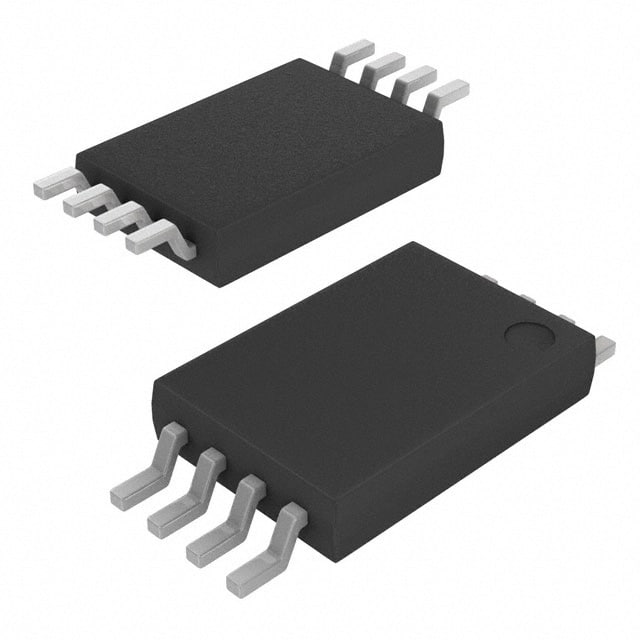AT24C256-10TI-1.8
Product Overview
Category
AT24C256-10TI-1.8 belongs to the category of EEPROM (Electrically Erasable Programmable Read-Only Memory) chips.
Use
This product is commonly used for non-volatile data storage in various electronic devices, such as microcontrollers, computers, and consumer electronics.
Characteristics
- Non-volatile: The stored data remains intact even when power is removed.
- Electrically erasable and programmable: Data can be erased and reprogrammed electronically.
- High storage capacity: The AT24C256-10TI-1.8 has a capacity of 256 kilobits (32 kilobytes).
- Low power consumption: It operates at a low voltage and consumes minimal power.
- Wide operating temperature range: It can function reliably in temperatures ranging from -40°C to +85°C.
Package
The AT24C256-10TI-1.8 is available in a standard 8-pin DIP (Dual Inline Package) or SOIC (Small Outline Integrated Circuit) package.
Essence
The essence of this product lies in its ability to provide reliable and non-volatile data storage in electronic devices.
Packaging/Quantity
The AT24C256-10TI-1.8 is typically packaged in reels or tubes, with each reel containing a specified quantity of chips. The exact packaging and quantity may vary depending on the manufacturer.
Specifications
- Capacity: 256 kilobits (32 kilobytes)
- Operating Voltage: 1.8V
- Maximum Clock Frequency: 400 kHz
- Write Cycle Time: 10 ms (maximum)
- Data Retention: 100 years (minimum)
Detailed Pin Configuration
The AT24C256-10TI-1.8 has the following pin configuration:
- A0: Chip Address Input
- A1: Chip Address Input
- A2: Chip Address Input
- GND: Ground
- SDA: Serial Data Input/Output
- SCL: Serial Clock Input
- WP: Write Protect
- VCC: Power Supply
Functional Features
- Random Access: Allows reading and writing of data at any memory location.
- Byte-Level Read and Write: Enables manipulation of individual bytes within the memory.
- Page Write: Supports writing multiple bytes in a single operation, improving efficiency.
- Software Write Protection: Provides the option to protect specific memory areas from being overwritten.
- Sequential Read: Facilitates continuous reading of data without requiring repeated address input.
Advantages and Disadvantages
Advantages
- Non-volatile storage ensures data integrity even during power loss.
- Electrically erasable and programmable nature allows for easy updates and modifications.
- High storage capacity accommodates a wide range of applications.
- Low power consumption prolongs battery life in portable devices.
- Wide operating temperature range makes it suitable for various environments.
Disadvantages
- Limited write endurance: The EEPROM has a finite number of write cycles before degradation.
- Relatively slower write speed compared to other memory technologies.
- Higher cost per bit compared to some alternative memory solutions.
Working Principles
The AT24C256-10TI-1.8 utilizes a combination of floating gate transistors and electrically isolated gates to store and retrieve data. When data is written, an electrical charge is applied to the floating gate, altering its threshold voltage. This change in threshold voltage represents the stored data. During read operations, the threshold voltage is measured to determine the stored information.
Detailed Application Field Plans
The AT24C256-10TI-1.8 finds application in various fields, including:
- Embedded Systems: Used for storing configuration data, firmware updates, and user settings in microcontrollers and IoT devices.
- Automotive Electronics: Employed for storing critical data like mileage, calibration values, and vehicle settings.
- Consumer Electronics: Utilized in devices such as smart TVs, set-top boxes, and gaming consoles for storing user preferences and application data.
- Industrial Automation: Used for storing parameters, calibration data, and event logs in programmable logic controllers (PLCs) and industrial control systems.
Detailed and Complete Alternative Models
Some alternative models to the AT24C256-10TI-1.8 include:
- AT24C01A: 1 kilobit (128 bytes) capacity, 1.8V operating voltage.
- AT24C512C: 512 kilobits (64 kilobytes) capacity, 1.8V operating voltage.
- AT24CM02: 2 megabits (256 kilobytes) capacity, 1.8V operating voltage.
- AT25080B: 8 kilobits (1 kilobyte
Senaraikan 10 soalan dan jawapan biasa yang berkaitan dengan aplikasi AT24C256-10TI-1.8 dalam penyelesaian teknikal
Sure! Here are 10 common questions and answers related to the application of AT24C256-10TI-1.8 in technical solutions:
Q: What is the AT24C256-10TI-1.8? A: The AT24C256-10TI-1.8 is a 256-kilobit (32,768 x 8) serial Electrically Erasable Programmable Read-Only Memory (EEPROM) chip.
Q: What are the key features of the AT24C256-10TI-1.8? A: Some key features include a wide operating voltage range (1.7V to 5.5V), low power consumption, and a high-speed I2C-compatible interface.
Q: How can the AT24C256-10TI-1.8 be used in technical solutions? A: It can be used for storing configuration data, user settings, or other non-volatile information in various electronic devices.
Q: What is the maximum data transfer rate of the AT24C256-10TI-1.8? A: The maximum data transfer rate is 400 kHz for the I2C interface.
Q: Can the AT24C256-10TI-1.8 be used in battery-powered devices? A: Yes, it has low power consumption and can operate within a wide voltage range, making it suitable for battery-powered applications.
Q: How much data can the AT24C256-10TI-1.8 store? A: It can store up to 256 kilobits (32 kilobytes) of data.
Q: Is the AT24C256-10TI-1.8 compatible with other microcontrollers or microprocessors? A: Yes, it is compatible with a wide range of microcontrollers and microprocessors that support the I2C protocol.
Q: Can the AT24C256-10TI-1.8 be reprogrammed multiple times? A: Yes, it is an Electrically Erasable Programmable Read-Only Memory (EEPROM), which means it can be reprogrammed multiple times.
Q: What is the typical endurance of the AT24C256-10TI-1.8? A: It has a typical endurance of 1 million write cycles.
Q: Are there any specific precautions to consider when using the AT24C256-10TI-1.8? A: It is important to follow the recommended operating conditions, such as voltage levels and temperature ranges, specified in the datasheet for optimal performance and reliability.
Please note that these answers are general and may vary depending on the specific application and requirements. It is always recommended to refer to the datasheet and consult the manufacturer for detailed information.


